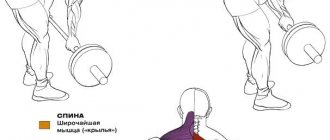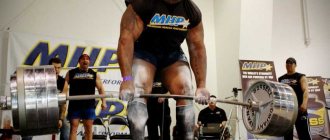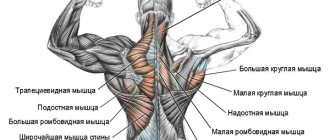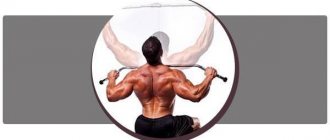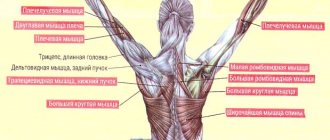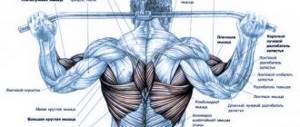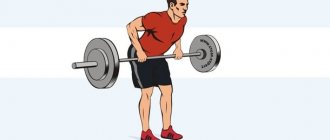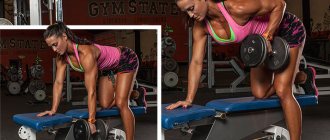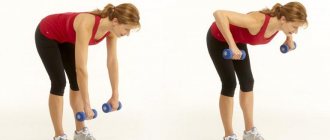What is horizontal block thrust
The horizontal pull-down is a strength exercise for developing the back muscles, which is performed on a pulley machine. It is also called the lat pull-down and simply the abdominal pull-down.
Horizontal block thrust. Photo: Yulia Obolenskaya
To perform it, a V-shaped or wide handle is attached to the lower block, a person sits on a bench, puts his feet on special supports and, bending his elbows, pulls the handle to his stomach.
How to do the exercise correctly?
The horizontal block pull, as we have already found out, affects a fairly wide array of muscle tissue. In particular, those involved in performing traction are:
- trapezoidal and diamond-shaped (the trapezoid is described in detail in the article Vertical traction);
- latissimus dorsi muscle (more about it in the article about the Pullover exercise);
- back extensor muscles;
- rear deltoids;
- biceps, triceps;
- muscles of the forearm.
In order for the load to be distributed evenly between them, it is important to be able to observe the subtleties of the execution technique. For example, horizontal rows are always performed on a block simulator. The only differences in implementation options are:
- principle of implementation (with a narrow or wide grip), for each of which the use of a special handle is provided;
- the magnitude of the amplitude being worked out.
For example, those athletes who focus their attention on working their biceps during training perform horizontal rows with a narrow grip and a wide amplitude (see photo below).
At the same time, the reduced amplitude of the reproduced actions in combination with a wide grip allows you to develop the back muscles. In addition, a wide grip makes it possible to lift maximum weights without the threat of injury to the back and spine. The technique of this exercise involves the use of a special handle for a wide grip and a limited range of actions.
When faced with such an exercise for the first time, many novice athletes not only cannot determine the most optimal deadlift option for themselves, but in general, there is not much difference in the grip with which the exercise will be performed.
The main thing is to choose exactly the movement and amplitude that will ensure deep development of all muscle groups in equal proportions.
We will talk further about how to correctly perform a horizontal block pull to the belt in different variations.
What is good about horizontal block traction?
This exercise targets the latissimus dorsi, mid-trapezius, and spinal extensors even better. Variations in muscle activation levels during traditional latissimus dorsi weight training exercises: An experimental study, ACE-SPONSORED RESEARCH: What Is the Best Back Exercise? than the lat pull-down, an exercise that is often used to strengthen the back and prepare for pull-ups.
Abdominal pulls also target your hamstrings, elbow flexors, and strengthen your spinal erectors—muscles that are critical to your back health and ability to lift heavy weights in exercises like deadlifts and squats.
In addition, this movement is as simple and comfortable as possible, does not require long mastery and is suitable even for absolute beginners.
Which handle to use for horizontal block rows?
Most often, horizontal block rows are performed with a V-shaped handle. Due to the narrow grip at the extreme point of the exercise, the elbows are located close to the body, which allows you to clearly feel the latissimus dorsi muscles.
Much less often they use a horizontal handle, with which you can perform movements with your hands shoulder-width apart. Essentially, this execution is similar to the bent-over barbell row, which is slightly better than ACE-SPONSORED RESEARCH: What Is the Best Back Exercise? pumps up the middle and lower part of the trapezius than working on a block.
Canadian bodybuilder and powerlifter Jeff Nippard suggested that abducting the shoulders at a greater angle during the deadlift increases the retraction of the shoulder blades, and therefore the load on the mid-trapezius and rear deltoids.
Whether you use this option or not is up to you. In any case, first you should master the movement with a V-shaped handle in order to get a good feel for how the back muscles work.
Which is better, pull-ups or machine rows?
What bodybuilder doesn’t dream of pumped up “wings”? It is the well-developed back muscles that give the athlete’s torso the desired “triangular” shape. This article is intended to answer the question: which exercise, pull-ups or pull-downs, is better for developing the lats? Do they have advantages or disadvantages? Since pull-ups can be performed in many different ways, it should be noted that we are talking exclusively about wide-grip pull-ups. The same muscle groups are involved in both exercises, and the same load is applied to the main muscles. Only small muscles work differently.
Anatomical features
The essence of both exercises is to bring the raised elbows towards the body. During this process, the shoulder blades rotate and retract. When the elbows are brought towards the torso, there is a load on the latissimus muscles, the lower part of the pectoral muscles and the large round muscles of the back. The rhomboid and pectoralis minor muscles are responsible for rotating the shoulder blades. The middle trapezius and rhomboid muscles move the shoulder blades outward.
There are no fundamental differences between these exercises
The difference between the two exercises is negligible. It consists in the position of the body relative to the hand grip of the crossbar or the handle of the exercise machine. But it is precisely this circumstance that determines the load on the small muscles.
Features of pull-ups
In the starting position, the body is located under the crossbar, arms in a vertical position. The main load goes to the top of the latissimus and teres major muscles. The arms, deltoids and chest are slightly involved.
Pros of exercise
- Strong emphasis on the back muscles.
- Weak amplitude.
- Development of coordination (working with your weight).
- The load is removed from the spine.
- Availability (you only need a horizontal bar).
Pull down on the block
Starting position: the handle is located in front of the body, the arms are at an angle to the body. During the exercise, the elbows are slightly pulled back, which puts additional stress on the back of the deltas. The middle trapezius and rhomboid muscles are also included. Of course, when part of the load is taken by the assistant muscles, the emphasis on the latissimus decreases.
Conclusion
This exercise is more effective for general core development; the latissimus muscles are less involved.
Grand total
The above exercises do not replace, but complement one another. It is advisable that both of them be in the bodybuilder’s arsenal. It is recommended to alternate them (for example, one month, then another) so that the muscles do not “get used to it.”
PULL-UPS or PULL-UPS! What's Better For a Bump?!
Igor July 31, 2013
What mistakes should you avoid?
Despite the simplicity of the movement, there are several mistakes that can reduce the benefits of the exercise:
- Slouched or arched back . Try to keep it straight, without rounding or excessive arching in the lower back.
- Body swing . Keep your core stable and pull the handle using muscle strength rather than inertia.
- Sharp return of the handle . The eccentric phase of the movement - when you return the handle to the starting position - also loads the muscles. By relaxing in this phase, you take the load off your back and arms.
- Raised shoulders. If you lift your shoulders toward your ears and don't squeeze your shoulder blades, your lats and trapezius will work much less than your biceps. As a result, the exercise will not give the desired effect. Watch the position of your shoulder blades and concentrate on working your back muscles.
Execution technique
Take the correct starting position. Sit on the machine and place your feet under the special support rollers. Grasp the handle with a wide grip and straighten your back. At the top point, the arms are extended, the elbows are extended, but the muscles are not relaxed, but are in good shape.
The pull is performed as follows:
- As you exhale, pull the cable handle down. Move your head slightly forward and lower the handle to a level just below the back of your head. During movement, the gaze is directed forward, the straight position of the back is maintained, and the elbows move in an arc in a plane perpendicular to the floor.
- At the bottom point, hold for several counts and, while inhaling, slowly return to the starting position.
- Repeat the described movement 10–15 times.
Additional attention should be paid to the grip. As was said, the grip is wide. But how much? With the correct grip, when you bend your elbows at right angles, your forearms are perpendicular to the floor. This is about one and a half times wider than the shoulders.
You should also take into account the fact that deadlifts additionally engage the biceps. Performing the movement by bending your arms is one of the most common mistakes in this exercise. To avoid it, concentrate on your elbows. It is the elbows that move downwards with force, and the forearms and hands are simply hooks with which you catch the weight.
If during a lat workout you feel that your biceps are tired much faster than the set is completed, then you are doing the exercise incorrectly. Try to perform the movement using your back - it is the back that should get tired.
How else can you perform horizontal block rows?
If the cable machine is busy or you are working out at home, you can perform this movement differently.
In the crossover
Attach the handle to the lower block of the crossover, sit on the floor, rest your feet on the racks and perform abdominal pull-downs, observing all technical aspects.
You can also sit on a bench and adjust the exercise machine so that the cable is at waist level.
Photo: Alexander Starostin
With expander
Sit on the floor, put an expander over your legs and pull its ends towards your stomach. You can also hook a resistance band to a stable support at abdominal level and perform the movement while sitting in a chair.
How to Add Lat Pulldowns to Your Workout
If you work in splits, perform the horizontal pull-down on the day of working your back, combining it with other movements for pumping up the lats and trapezius: lat pull-downs, pull-ups and bent-over barbell rows.
If you're pumping your whole body in one workout, do lat pull-downs once a week, and use other back exercises on the other days. This approach will allow you to harmoniously pump all the back muscles and provide them with a variety of stimuli for growth.
Common execution errors
You should know that even with the slightest violation of the correct technique, the load will be transferred from the target muscles to either the biceps or the lower back. In some cases, this can even be dangerous. Therefore, be careful not to make the following mistakes:
- Do not round your back throughout the exercise - this will cause excessive stress on the spine;
- Do not direct your gaze downward, otherwise this will lead to rounding of the spine;
- Pull the weight not with your arms, but with your back. You should clearly feel that it is the lats that are involved in the movement, and not the biceps;
- Do not perform jerking rows - this puts harmful stress on the joints;
- Do not push off the supports with your feet to make the exercise easier.
If for some reason you cannot or do not want to perform this exercise, then you have probably thought about how to replace the horizontal block row. As a replacement, you can use a horizontal row on a lever machine, a T-bar row, or a bent-over dumbbell row.
